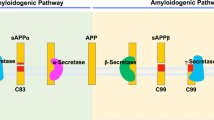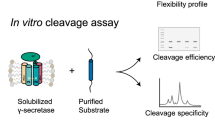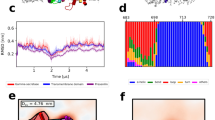Abstract
γ-Secretase — a protease that cleaves within the membrane — was first recognized for its role in the production of amyloidogenic Aβ peptides, but was subsequently found to mediate Notch signalling by releasing the Notch-receptor intracellular domain. Many other γ-secretase substrates have recently been identified, which indicates a broader biological function for this unusual protease. Emerging evidence implies that whereas some intracellular cleavage products of γ-secretase function as signalling molecules, others might simply be intermediates that are destined for degradation.
This is a preview of subscription content, access via your institution
Access options
Subscribe to this journal
Receive 12 print issues and online access
$209.00 per year
only $17.42 per issue
Buy this article
- Purchase on SpringerLink
- Instant access to full article PDF
Prices may be subject to local taxes which are calculated during checkout


Similar content being viewed by others
References
Brown, M. S., Ye, J., Rawson, R. B. & Goldstein, J. L. Regulated intramembrane proteolysis: a control mechanism conserved from bacteria to humans. Cell 100, 391–398 (2000).
Urban, S. & Freeman, M. Intramembrane proteolysis controls diverse signaling pathways throughout evolution. Curr. Opin. Genet. Dev. 12, 512–518 (2002).
Rawson, R. B. Regulated intramembrane proteolysis: from the endoplasmic reticulum to the nucleus. Essays Biochem. 38, 155–168 (2002).
Ye, J. et al. ER stress induces cleavage of membrane-bound ATF6 by the same proteases that process SREBPs. Mol. Cell 6, 1355–1364 (2000).
Mumm, J. S. & Kopan, R. Notch signaling: from the outside in. Dev. Biol. 228, 151–165 (2000).
Fortini, M. E. γ-secretase-mediated proteolysis in cell-surface-receptor signalling. Nature Rev. Mol. Cell Biol. 3, 673–684 (2002).
Nam, Y., Weng, A. P., Aster, J. C. & Blacklow, S. C. Structural requirements for assembly of the CSL–intracellular notch1–mastermind-like 1 transcriptional activation complex. J. Biol. Chem. 278, 21232–21239 (2003).
Fryer, C. J., Lamar, E., Turbachova, I., Kintner, C. & Jones, K. A. Mastermind mediates chromatin-specific transcription and turnover of the notch enhancer complex. Genes Dev. 16, 1397–1411 (2002).
Selkoe, D. & Kopan, R. Notch and presenilin: regulated intramembrane proteolysis links development and degeneration. Annu. Rev. Neurosci. 26, 565–597 (2003).
Struhl, G. & Adachi, A. Requirements for presenilin-dependent cleavage of notch and other transmembrane proteins. Mol. Cell 6, 625–663 (2000).
Golde, T. E. & Eckman, C. B. Physiologic and pathologic events mediated by intramembranous and juxtamembranous proteolysis. Sci. STKE 4 Mar 2003 (doi:10.1126/stke.2003.172.re4).
Ho, A. & Sudhof, T. C. Binding of F-spondin to amyloid-β precursor protein: a candidate amyloid-β precursor protein ligand that modulates amyloid-β precursor protein cleavage. Proc. Natl Acad. Sci. USA 101, 2548–2553 (2004).
McGuire, J. K., Li, Q. & Parks, W. C. Matrilysin (matrix metalloproteinase-7) mediates E-cadherin ectodomain shedding in injured lung epithelium. Am. J. Pathol. 162, 1831–1843 (2003).
Marambaud, P. et al. A CBP binding transcriptional repressor produced by the PS1/ε-cleavage of N-cadherin is inhibited by PS1 FAD mutations. Cell 114, 635–645 (2003).
Okamoto, I. et al. Proteolytic release of CD44 intracellular domain and its role in the CD44 signaling pathway. J. Cell Biol. 155, 755–762 (2001).
LaVoie, M. J. & Selkoe, D. J. The notch ligands, jagged and delta, are sequentially processed by α-secretase and presenilin/γ-secretase and release signaling fragments. J. Biol. Chem. 278, 34427–34437 (2003).
Cao, X. & Sudhof, T. C. A transcriptively active complex of APP with Fe65 and histone acetyltransferase Tip60. Science 293, 115–120 (2001).
Baek, S. H. et al. Exchange of N-CoR corepressor and Tip60 coactivator complexes links gene expression by NF-κB and β-amyloid precursor protein. Cell 110, 55–67 (2002).
Kinoshita, A., Shah, T., Tangredi, M. M., Strickland, D. K. & Hyman, B. T. The intracellular domain of the low density lipoprotein receptor-related protein modulates transactivation mediated by amyloid precursor protein and Fe65. J. Biol. Chem. 278, 41182–41188 (2003).
Ni, C. Y., Murphy, M. P., Golde, T. E. & Carpenter, G. γ-Secretase cleavage and nuclear localization of ErbB-4 receptor tyrosine kinase. Science 294, 2179–2181 (2001).
Ni, C. Y., Yuan, H. & Carpenter, G. Role of the ErbB-4 carboxyl terminus in γ-secretase cleavage. J. Biol. Chem. 278, 4561–4565 (2003).
Rao, P. & Kadesch, T. The intracellular form of notch blocks transforming growth factor β-mediated growth arrest in Mv1Lu epithelial cells. Mol. Cell Biol. 23, 6694–6701 (2003).
Yu, C. et al. Characterization of a presenilin-mediated amyloid precursor protein carboxyl-terminal fragment γ. Evidence for distinct mechanisms involved in γ-secretase processing of the APP and Notch1 transmembrane domains. J. Biol. Chem. 276, 43756–43760 (2001).
Marambaud, P. et al. A presenilin-1/γ-secretase cleavage releases the E-cadherin intracellular domain and regulates disassembly of adherens junctions. EMBO J. 21, 1948–1956 (2002).
Huppert, S. et al. Embryonic lethality in mice homozygous for a processing deficient Notch1 allele. Nature 405, 966–970 (2000).
Schulz, J. G. et al. Syndecan 3 intramembrane proteolysis is presenilin/γ-secretase-dependent and modulates cytosolic signaling. J. Biol. Chem. 278, 48651–48657 (2003).
Hsueh, Y. P., Wang, T. F., Yang, F. C. & Sheng, M. Nuclear translocation and transcription regulation by the membrane-associated guanylate kinase CASK/LIN-2. Nature 404, 298–302 (2000).
Arribas, J. & Borroto, A. Protein ectodomain shedding. Chem. Rev. 102, 4627–4638 (2002).
Annaert, W. & De Strooper, B. A cell biological perspective on Alzheimer's disease. Annu. Rev. Cell Dev. Biol. 18, 25–51 (2002).
Cupers, P., Orlans, I., Craessaerts, K., Annaert, W. & De Strooper, B. The amyloid precursor protein (APP)-cytoplasmic fragment generated by γ-secretase is rapidly degraded but distributes partially in a nuclear fraction of neurones in culture. J. Neurochem. 78, 1168–1178 (2001).
Edbauer, D., Willem, M., Lammich, S., Steiner, H. & Haass, C. Insulin-degrading enzyme rapidly removes the β-amyloid precursor protein intracellular domain (AICD). J. Biol. Chem. 277, 13389–13393 (2002).
Six, E. et al. The Notch ligand Delta1 is sequentially cleaved by an ADAM protease and γ-secretase. Proc. Natl Acad. Sci. USA 100, 7638–7643 (2003).
Pasternak, S. H. et al. Presenilin, nicastrin, amyloid precursor protein, and γ-secretase activity are co-localized in the lysosomal membrane. J. Biol. Chem. 278, 26687–26694 (2003).
Schenk, D. Alzheimer's disease. A partner for presenilin. Nature 407, 34–35 (2000).
Small, D. H. Is γ-secretase a multienzyme complex for membrane protein degradation? Models and speculations. Peptides 23, 1317–1321 (2002).
Israel, A. A role for phosphorylation and degradation in the control of NF-κB activity. Trends Genet. 11, 203–205 (1995).
Lefers, M. A. & Holmgren, R. Ci proteolysis: regulation by a constellation of phosphorylation sites. Curr. Biol. 12, R422–R423 (2002).
Noureddine, M. A., Donaldson, T. D., Thacker, S. A. & Duronio, R. J. Drosophila Roc1a encodes a RING-H2 protein with a unique function in processing the Hh signal transducer Ci by the SCF E3 ubiquitin ligase. Dev. Cell 2, 757–770 (2002).
Hoppe, T., Rape, M. & Jentsch, S. Membrane-bound transcription factors: regulated release by RIP or RUP. Curr. Opin. Cell Biol. 13, 344–348 (2001).
Weihofen, A. & Martoglio, B. Intramembrane-cleaving proteases: controlled liberation of proteins and bioactive peptides. Trends Cell Biol. 13, 71–78 (2003).
Schroeter, E. H. et al. A presenilin dimer at the core of the γ-secretase enzyme: insights from parallel analysis of Notch 1 and APP proteolysis. Proc. Natl Acad. Sci. USA 100, 13075–13080 (2003).
Adams, J. The proteasome: structure, function, and role in the cell. Cancer Treat. Rev. 29 (Suppl. 1), 3–9 (2003).
Walsh, D. M. et al. γ-Secretase cleavage and binding to FE65 regulate the nuclear translocation of the intracellular C-terminal domain (ICD) of the APP family of proteins. Biochemistry 42, 6664–6673 (2003).
Wilhelmsen, K. & van der Geer, P. Phorbol 12-myristate 13-acetate-induced release of the colony-stimulating factor 1 receptor cytoplasmic domain into the cytosol involves two separate cleavage events. Mol. Cell. Biol. 24, 454–464 (2004).
Taniguchi, Y., Kim, S. H. & Sisodia, S. S. Presenilin-dependent γ-secretase processing of deleted in colorectal cancer (DCC). J. Biol. Chem. 278, 30425–30428 (2003).
Kim, D. Y., Ingano, L. A. & Kovacs, D. M. Nectin-1α, an immunoglobulin-like receptor involved in the formation of synapses, is a substrate for presenilin/γ-secretase-like cleavage. J. Biol. Chem. 277, 49976–49981 (2002).
Jung, K. M. et al. Regulated intramembrane proteolysis of the p75 neurotrophin receptor modulates its association with the TrkA receptor. J. Biol. Chem. 278, 42161–42169 (2003).
Cao, X. & Sudhof, T. C. Dissection of APP-dependent transcriptional transactivation. J. Biol. Chem. 24 Mar 2004 (doi:10.1074/jbc.M402248200).
Acknowledgements
We would like to thank the organizers and participants of the Horizon Symposium that triggered this perpective article and, specifically, Bill Parks for reading and commenting on the manuscript.
Author information
Authors and Affiliations
Corresponding author
Ethics declarations
Competing interests
The authors declare no competing financial interests.
Supplementary information
Related links
Related links
DATABASES
Flybase
Swiss-Prot
Rights and permissions
About this article
Cite this article
Kopan, R., Ilagan, M. γ-Secretase: proteasome of the membrane?. Nat Rev Mol Cell Biol 5, 499–504 (2004). https://doi.org/10.1038/nrm1406
Issue Date:
DOI: https://doi.org/10.1038/nrm1406



